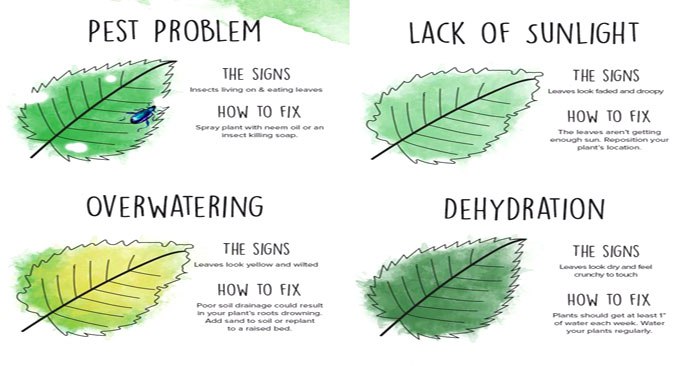
Article Detail
22 Aug
If you want to ‘show off your green thumb’ with your beautiful home or garden plants, you should know that there is a simple way to achieve this. Even if the condition of your plants is urging you to ask yourself whether you actually possess any skills to be a gardener, there’s no room for any fuss.
This helpful ‘primer for sick plant leaves’ will teach you simple wisdom to help you be a ‘plant doctor’ and have more green patches around you. All plants, just like other living creatures, require certain ‘positive conditions’ to thrive and grow.
Too little sunlight (or even too much of it), too much water (or even too little of it), and too many bugs are but a few things that can transform your awesome plants from stunning to sickly almost in a snap.
We encourage you to simply do the checks [shown in the pictures below] on the most frequent reasons why your greenery may not be thriving as expected:
- Pest check:
Believe it or not, nasty bug life can inflict a surprisingly big amount of damage on your plants, especially with regard of their size. You will easily notice bugs ‘riding’ on the leaves, and you may even see holes where the bugs have been enjoying lunch. Try to do spraying of your plants with insecticide, but preferable with less harmful homemade ones.
- Water check:
Well, it is usually pretty obvious that your plants are thirsty for water, but you can overwater a plant as well. So, search for leaves that are yellowing and wilted. Also, try to re-pot your plant in soil with better drainage and keep a “lighter hand” when watering.
- Sunlight check:
If your plants start to look droopy and tired, they may not be getting enough sunlight. The sun helps the plant produce the food it needs to grow by itself. So, make sure your plants are getting enough sun by moving them to brighter spots during the day.
In addition to good amount of water and sunlight, your plant may need a ‘shot’ of mineral cocktail to get more perk in its leaves. Common deficiencies include:
- potassium deficiency
- zinc deficiency
- nitrogen deficiency
- iron deficiency
Yellowing on the leaves’ edges, or light discoloration all over the leaf, are sure signs that your plants may be lacking one or more of the above minerals.
All plantlets need a mix of micro- and macro-nutrients to thrive because these nutrients are essential for a healthy plant growth. Macronutrients [like calcium, sulfur, magnesium, and nitrogen] can be found in lime and in natural composts.
Plants also need micronutrients [like boron, copper, iron, chloride, and zin] to grow, but they need less of them, according to NCAGR.
You can do the trick with adding a bit of lawn clippings to your plants to provide enough micronutrients for them. However, it is very important to watch your plants and monitor them for small changes so that you can adjust the water, sunlight or nutrient levels at the first sign of these deficiencies.


